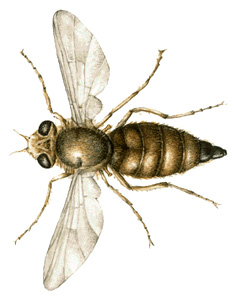Bot fly is the name of various kinds of harmful flies. Their larvae, called maggots, live as parasites in livestock, wild animals, and human beings (see Larva). These maggots eat the tissues or fluids of the living body. The infestation of fly maggots in people or in animals is called myiasis. Many animals die from infestation with bot fly maggots. Human beings may be seriously affected.

The horse bot flies are among the most common types of bot flies in the United States. The female flies lay their eggs on the hair of the horse’s legs or jaws, or on or near the lips. The eggs hatch into maggots called bots, which enter the body of the horse. They work their way to its stomach, where they irritate the stomach lining and cause digestive disturbances.
Another group of bot flies, called heel flies or warble flies, lay their eggs on the legs or hindquarters of cattle. The larvae, known as cattle grubs, burrow through the skin and travel through the body until they reach the back. They make holes in the skin, through which they breathe while they develop just under the surface. They remain inside the infested animal as they develop and grow for nearly a year before they leave its body, dropping to the ground to develop further.
The sheep bot fly deposits its larvae in the nostrils of sheep and goats. The larvae crawl into the cavities of the nose and the head sinuses. They leave the animal’s body later to complete their development.
Insecticides are used to kill bot flies in horses. These insecticides are given by mouth in a capsule or stomach tube. Some insecticides that are sprayed or poured on are effective against grubs in beef cattle. Various chemicals are injected into the sinuses of sheep to kill grubs.
The bot flies that infest human beings are found in the tropics. The female bot fly catches a mosquito, some other bloodsucking fly, or a tick and attaches its eggs to the captured animal’s abdomen. These eggs hatch into bots. When the infested animal bites a human being, the bots enter the person’s skin.
